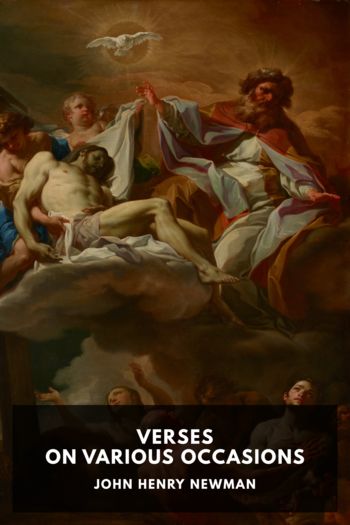Don Quixote Miguel de Cervantes Saavedra (mobile ebook reader .txt) 📖

- Author: Miguel de Cervantes Saavedra
Book online «Don Quixote Miguel de Cervantes Saavedra (mobile ebook reader .txt) 📖». Author Miguel de Cervantes Saavedra
The Cordovan leather, a legacy of the Moors, was somewhat like morocco. ↩
Cervantes has introduced the same story, with some slight modifications, in the interlude of the Elleción de los Alcaldes de Daganzo. ↩
Proverb 116. ↩
The colossal statue of Faith that acts as weathercock on the top of the great Moorish tower of the same name which serves as belfry to the Cathedral at Seville. ↩
Rude stone figures of animals resembling the hippopotamus rather than the bull, the origin of which is a disputed point among Spanish antiquarians. They are not, however, confined to Guisando; there are, for instance, four well-preserved specimens at Avila. ↩
A chasm in the Sierra de Cabra, south of Cordova, probably the shaft of an ancient mine. ↩
Lines quoted, but incorrectly, from the beginning of the Araucana of Ercilla, who apparently borrowed them from the old poet the Archpriest of Hita. ↩
Proverb 164. ↩
I.e., seconds. ↩
The fine imposed in some fraternities on absent members. ↩
Apetites. Hartzenbusch proposes arbitrios—“expedients;” but it is hardly a case that calls for emendation, and there is a flavour of Sancho in the idea as it stands. ↩
Proverb 248. According to Covarrubias, a metaphor taken from rabbit-shooting with the crossbow, when each sportsman should confine his attention to looking for his own arrows, or, more properly, bolts, virotes. ↩
Proverb 124. ↩
Proverb 81. ↩
The formal commencement of the answer to a petition to the crown. ↩
The old form of spur was a spike with a knob or button near the point to keep it from penetrating too far. ↩
Proverb 94. ↩
A reference to the proverb (185), “The bay is of one mind, he who saddles him of another.” ↩
Proverb 155. ↩
Gabán, a loose overcoat with a hood, worn when hunting, hawking, or travelling; montera, a cap with falling flaps, a common head gear in Central Spain. ↩
Jineta, an easy saddle with short stirrups, already referred to in this note. ↩
All editions previous to Hartzenbusch’s read caballo—“horse”—instead of cabello, but we are told, and the whole context shows, that it was Don Quixote’s personal appearance that astonished Don Diego; it is true that Rocinante is described as “long” in Part I Chapter IX. ↩
In Chapter III, the reader may remember, the number is put at “more than twelve thousand.” Perhaps, between writing that chapter and this, Cervantes may have heard of other editions besides those he mentions there; but even counting all editions his estimate is excessive. ↩
Proverb 6. ↩
Clemencín seems to think that it should be, not perdigon—“partridge”—but perdiguero—“pointer;” but Cervantes would never have applied the word manso—“tame”—to a dog. Clemencín apparently was not aware that tame partridges are extensively used by Andalusian sportsmen as decoys. ↩
This is an instance of the heedless way in which Cervantes so often wrote. He meant, of course, that having many and good children was one of those things (such as, for example, the gifts of fortune, etc.) wherein the philosophers placed the summum bonum. ↩
Justas literarias—literary or poetical jousts or tournaments, in which the compositions of the competitors were recited in public, and prizes awarded by appointed judges, were still frequent in the time of Cervantes. ↩
I.e., Ovid. Fasti, Lib. VI and De Arte Amandi, Lib. III. ↩
Like Ovid, banished to Tomos in Pontus. ↩
I.e., the laurel. ↩
The opening sentences have been transferred to this place from Chapter X by Hartzenbusch. It would be absurd to call Don Quixote’s simplicity in the matter of Sancho’s mystification about the village girls, mad doings (locuras) that go beyond the maddest that can be conceived; while the lion adventure is all through treated as his very maddest freak; one compared with which, as Sancho says, all the rest were “cakes and fancy bread.” ↩
Proverb 240. May be drawn out fine like wire. ↩
Proverb 241. ↩
Proverb 14. ↩
Don Quixote, going to Saragossa, could not have met the cart with lions coming from Cartagena, where they would have been landed from Oran. ↩
Referring to Don Manuel Ponce de León, one of the most brilliant of the galaxy of gallant knights round Ferdinand and Isabella at the siege of Granada, and hero, according to Spanish tradition, of the story told by Schiller in Der Handschuh, by Leigh Hunt in the Glove and the Lions, but best of all by Robert Browning in The Glove. Although, with these, the hero’s name is De Lorge and the scene the Court of Francis I of France, the story is originally a Spanish one. It was transferred to France by Brantôme in Discours X of his Dames Illustres. He took it from No. 89 of Part III of Bandello’s novels, and Bandello had it from a Valencian or Catalan source. It appears in different forms in old Spanish literature. It is mentioned in the Nobiliario of Alonso López de Haro, who, however, says





Comments (0)